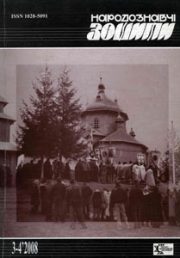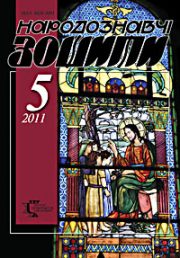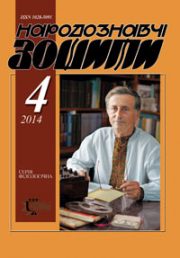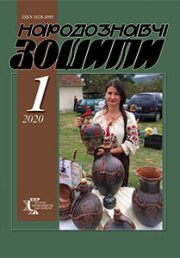The Ethnology Notebooks. 2019, 2 (146), 328—345
UDK 398.332.1/.2:58(=161.2:477:292.452)
DOI https://doi.org/10.15407/nz2019.02.328
THE BELIEFSASSOCIATED WITH TREES IN THE SPRING-SUMMER RITUALISM OF UKRAINIANS FROM CARPATHIAN REGION
GOSHCHYTSKA Tatyana
ORCID ID: https://orcid.org/0000-0001-8596-8974
Candidate of historical sciences / Doctor of Philosophy,
Researcher fellow of department of Historical Ethnology
of the Institute of Ethnology
The National Academy of Sciences of Ukraine,
15, Svobody Avenue, 79000, Lviv, Ukraine
Contacts: e-mail: hoshchitska.tetiana@gmail.com
Abstract. Introduction: The beliefs associated with the trees were expressed almost the most strikingly (compared with the other parts of the ceremonial culture) in the traditional ritualism of the spring-summer cycle of the Ukrainians of Carpathian region. Problem Statement: The use of the wood and its aloforms as a ritual attribute was embodied in: consecration of the branches of the trees; decoration of the house and yard with greenery as a way to provide protection timed to certain calendar dates; existence of various prejudices and omens associated with trees; establishment of «vicha» (a kind of «igornyi oak») on the pastures and public celebrations around it during specific holidays. Purpose: The purpose of the article is to systematize and analyze data on the use of aloforms of the tree and the beliefs associated with them in the traditional spring-summer rituals of the Ukrainian Carpathians. Methods: The main methods involved in the article are structural, comparative and analytical. Results: In the article in particular have been systemized and analyzed Ukrainians’traditional beliefs, warnings and prohibitions tied with the choice of certain plants for decorating of dwellings and homestead construction on the eve of the Trinity Festival. these attributes in the studied region, had a pronounced specificity which was used in a variety of ways (a set of attributes, a way of applying them to the ritual, the term of use, etc.). Moreover, these rituals remained rather fragile, although their original semantics was lost. Тhese attributes in the studied region, had a pronounced specificity which was used in a variety of ways (a set of attributes, a way of applying them to the ritual, the term of use, etc.). Conclusion: In general, the use of the trees as an important attribute of the rites should be linked, first of all, with the relics of the cults of the dead ancestors and the ritual of reception and passage of the deceased into «the other world», while marking the key dates from the most important period of the agricultural year.
Keywords: traditional ritualism, spring-summer cycle, Ukrainian Carpathians, beliefs, cult of vegetation.
Received 31.01.2019
REFERENCES
Tokarev, S.A. (1983). Introduction. In Calendar customs and ceremonies in countries of foreign Europe. Historical roots and development of customs (pp. 3—11). Моscow: Nauka [in Russian].
Аgapkina, Т.А. (2002). Mythopoietic foundations of the Slavic people’s calendar. Spring-summer cycle. Моscow: Indrik [in Russian].
Blyznak, I. (1937). Greenery-celebrational custom in the Boykivska area — Shtukivets. In Litopys Bojkivschyny: zapysky prysviacheni doslidam istorii, kul’tury i pobutu bojkivs’koho plemeni, 9, 120—121 [in Ukrainian].
Bogatyrev, P.G. (1971). Magicacts, rites and beliefs in Transcarpathia. In Questions of the theory of popular art (pp. 167—296). Моscow: Art [in Russian].
Buhera, I. (1939). Customs and beliefs of Lemkivshchyna. Lviv [in Ukrainian].
Hlavats’ka, L. (2011). Spring pastoral folk customs and rites of boiks (end of the 19th and mid-20th centuries). In Calendar ceremonies in the life of the ethnic group. Collection of scientific works. Materials of the international scientific conference «Odesa Ethnographic Readings». Odesa [in Ukrainian].
Zubryts’kyj, M. (1895). Houses and masters. Zhytie i slovo: vistnyk literatury, istorii i fol’kloru, 3, 71—75 [in Ukrainian].
Zubryts’kyj, M. (1900). Popular calendar, popular customs and speeches related to the days of the week and the year’s celebrations (recorded in Mshantsy, Starosambir povit and the villages nearby). Materialy do ukrains’ko-rus’koi etnolohii (Vol. III, pp. 33—60) [in Ukrainian].
Kolessa, F. (1898). Popular beliefs in Pidhiria in the Khodovychi village, Stryi povit, recorded by Filaret Kolessa. Etnohrafichnyj zbirnyk, V, 76—98 [in Ukrainian].
Krasovs’kyj, I. (2002). Calendar rituals. In Lemkivschyna (Vol. 2, pp. 113—123). Lviv: Instytut narodoznavstva NANU [in Ukrainian].
Onischuk, А. (1909). Materials to the Hutsul demonology, written in 1907—1908 in Zelenitsy, Nadvirna district by Antin Onischuk, the folk teacher. Materiialy do ukrains’koi etnol’ohii (Vol. ХІ, pp. 1—139) [in Ukrainian].
Sokil, V., & Sokil, H. (1998). Folklore materials from the fatherland. Lviv [in Ukrainian].
Franko, I. (1910). Galician-Russian folk sayings. In Etnohrafichnyj zbirnyk (Vol. 28, pp. 1—541) [in Ukrainian].
Shekeryk-Donnykiv, P. (2009). The year in beliefs of Hutsuls. Verkhovyna [in Ukrainian].
Halajchuk, V. (2006). Mythological representations about plants. In Ethnogenesis and ethnic history of the Ukrainian Carpathians (Vol. 2, pp. 590—608). Lviv: Instytut narodoznavstva NAN Ukrainy [in Ukrainian].
Pakholok, I. (2012). «May» («kletsannia») — the key attribute of the Green Holidays (Carpathian tradition). In Fortecia — the collection of «Tustan» reserve (pp. 574—582). Lviv [in Ukrainian].
Pakholok, I. (2013). Ethnographic specificity of troitski plants. The Ethnology Notebooks, 2 (11), 272—278 [in Ukrainian].
Propp, V.Y. (1963). Russian agrarian holidays. Experience of historical and ethnographic research. Leningrad: Izdatel’stvo Lenynhradskoho unyversyteta [in Russian].
Vlad, M. (1992). Stritennie. Book of Hutsul customs and beliefs. Кyiv: Ukrains’kyj pys’mennyk [in Ukrainian].
Franko, I. (1901). Galician-Russian folk sayings. In Etnohrafichnyj zbirnyk (Vol. Х, pp. 1—200) [in Ukrainian].
Samotis, Y. (2012—2013). Field ethnographic materials to the topic Traditional spring ritual of Ukrainians recorded in Bogorodchany, Kosiv and Verkhovyna districts of Ivano-Frankivsk region, Putyla district of Chernivtsi region; in the Great Bereznyansky and Perechyn districts of the Transcarpathian region). In Archive of the IN NANU. F. 1. Оp. 2. Оd save. 725. Arc. 1—145 [in Ukrainian].
Shukhevych, V. (1908). Hutsul’schyna. In Materialy z ukrains’ko-rus’koi etnolohii (Vol. VII, pp. 1— 272) [in Ukrainian].
Maksymovych, M. (2002). Days and months of the Ukrainian peasant: ethnographic research. Кyiv: Oberehy [in Ukrainian].
Salmanovych, M.Ya. (1977). Romanians. In Calendar customs and rites in the countries of foreign Europe. Spring holidays (pp. 296—312). Моscow: Nauka [in Russian].
Lemkivschyna: earth, people, history, culture. (1988). (Vol. 2). New-Jork; Paris; Sydnej; Toronto [in Ukrainian].
Sen’kiv, I. (1995). Hutsul heritage. Works about life and art of Hutsuls. Кyiv: Ukrainoznavstvo [in Ukrainian].
Zdoroveha, N.I. (1983). Popular customs and ordinances. In Boykivschyna: historical and ethnographic research (pp. 232—247). Кyiv: Naukova dumka [in Ukrainian].
Ostapyk. O. (1994). Field materials from the expedition to the Boikivshchyna. In Archive of the IN NANU. F. 1. Оp. 2. Оd. save 400. Arc. 1—56 [in Ukrainian].
Pasternak, Ya. (1929). Customs and beliefs in Zibolka village (Zhovkva povit). In Materialy z ukrains’ko-rus’koi etnolohii (Vol. 21—22, pp. 321—352) [in Ukrainian].
Goshchitska, T. (2008). Field ethnographic materials on the theme «People’s construction», collected in the Skole district of Lviv region. In Archive of the IN NANU. F. 1. Оp. 2. Odsave. 576. Arc. 1—72 [in Ukrainian].
Onyschuk, A. (1912). Popular Calendar. Customs and beliefs connected to single days in the year, recorded in 1907—1910 in Zelenitsy, Nadvirna district by Antin Onischuk, the folk teacher. In Materiialy do ukrains’koi etnolohii (Vol. ХV, pp. 1—61) [in Ukrainian].
Kylymnyk, S. (1994). Ukrainian year in the folk customs through the historical lens (Vol. 2). Kyiv: Oberehy [in Ukrainian].
Voropaj, O. (1993). The customs of our people. Ethnographic essay. Кyiv: Oberehy [in Ukrainian].
Аgapkina, Т.А. (1995). Essays on the spring ritual of Polissya. In Slavic and Balkan folklore (Ethnolinguistic study of Polissya) (pp. 21—107). Моscow: Indrik [in Russian].
Hantskaia, A.O. (1978). Poles. In Calendar customs and ceremonies in the countries of foreign Europe. Autumn-summer holidays (pp. 174—184). Моscow: Nauka [in Russian].
Ostapyk, O. (1982). Field materials from the expedition to Hutsulshchyna. In Archive of the IN NANU. F. 1. Оp. 2. Оd. save 409. Arc. 1—64 [in Ukrainian].
Ostapyk, O. (1991). Field materials from the expedition to the Starosambir district, to the Boykivshchyna. In Archive of the IN NANU. F. 1. Оp. 2. Od. save 370. Arc. 1—115 [in Ukrainian].
Hratsyanskaia, N.N. (1971). Czechs and Slovaks. In Calendar customs and rites in the countries of foreign Europe. Spring holidays (pp. 221—237). Моscow: Nauka [in Russian].
Kashuba, M.S. (1977). The peoples of Yugoslavia. In Calendar customs and ceremonies in countries of foreign Europe. Spring feasts (pp. 243—273). Моscow: Nauka [in Russian].
Shukhevych, V. (1904). Hutsul’schyna (Vol. V, pp. 1—301) [in Ukrainian].
Protsiv, O.R. (2017). Fishing of Galicia XVI — beg. XX: historiography and sources. Ivano-Frankivs’k [in Ukrainian].
Zhatkovych, Yu. (2007). Ethnographic overview of ugro-russians: complex edition. Uzhhorod: Mystets’ka liniia [in Ukrainian].
Kyrchiv, R. (2002). Oral folk art of boiks. In From the folklore regions of Ukraine. Essays and articles (pp. 34—114). Lviv: In-tut narodoznavstva NANU [in Ukrainian].
Kutel’makh, K. (1987). Popular customs and ordinances. Calendar rituals. In Huzulschyna: historical and ethnological research (pp. 286—301). Кyiv: Nauka dymka [in Ukrainian].
Pushyk, S. (2006). Vikha — the symbol of the tree of life. Ethnology and culture, 2—3, 231—239 [in Ukrainian].
Kashuba, M.S. (1977). The peoples of Yugoslavia. In Calendar customs and ceremonies in countries of foreign Europe. Spring feasts (pp. 243—273). Моscow: Nauka [in Russian].
Kolberg, O. (1973). Rus Karpatska (Part 1). In Works all (Vol. 54). Wrocіaw; Poznaс: Ludowa spoldzielnia wydawnicza [in Polish].
Fischer, A. (1928). Rusini: outline of ethnography of Rus. Lviv; Warsaw; Krakow [in Polish].
Sokolova, V. (1979). Spring-summer calendar rituals of Russians, Ukrainians and Byelorussians XIX — early XX. Моscow: Nauka [in Russian].
Kutel’makh, K. (2001). Mermaids in the beliefs of Polishchuky. In ZNTSH (Vol. ССХLІІ, pp. 87—153) [in Ukrainian].
Afanasyev, А.N. (1994). Poetic views of Slavs in regard to the Nature: The experience of comparative study of Slavic legends and beliefs connected to the myths of the other relative ethnos (Vol. 3). Моscow: Indrik [in Russian].
Rohashko, I. (2008). Field ethnographic materials for the topic «Summer calendars», recorded in Bogorodchany district of Ivano-Frankivsk region). In Archive of National lviv Franko University. F. 119. Оp. 17. Od. save 256-Е. Arc. 1—64 [in Ukrainian].
Pakholok, I. (2011). Field ethnographic materials on the theme «Green holidays in Ukrainians: traditional customs and ordinances» recorded in the Rogatyn district of Ivano-Frankivsk oblast). In Archive of National lviv Franko University. F. 119. Оp. 17. Od. save 347-Е. Arc. 1—9 [in Ukrainian].
Kolberg, O. (1962). Pocuzie: ethnographic picture (Part 1). In Works all (Vol. 29). Wrocіaw; Poznaс: Ludowa spoldzielnia wydawnicza [in Polish].
Kyrchiv, R.F. (1975). Field materials from the Turks and Velyky Bereznyansky districts. In Archive of the IN NANU. F. 1. Оp. 2. Od. save 215 [in Ukrainian].
Parkhomenko, T. (2009). Calendar customs and ceremonies. In Ethnoculture of Rivne Polissia (pp. 119—192). Rivne [in Ukrainian].
Hratsyanskaia, N.N. (1971). Czechs and Slovaks. In Calendar customs and rites in the countries of foreign Europe. Spring holidays (pp. 221—237). Моscow: Nauka [in Russian].
Falkowski, J., & Pasznycki, B. (1935). On the border between Lemko and Bojki. Ethnographic outline. Lviv [in Polish].
Zelenyn, D.K. (1937). Totem trees in the legends and rituals of the European peoples. Моscow-Leningrad: Izdatel’stvo AN SSSR [in Russian].
Halajchuk, V. (2010). Traditional calendar customs and rites of Starosambirshchyna. In ZNTSH (Vol. CCLIX, pp. 138—178) [in Ukrainian].
Kolberg, O. (1973). Rus Karpatska (Part 1). In Works all (Vol. 54). Wrocіaw-Poznaс: Ludowa spoldzielnia wydawnicza [in Polish].
Schnajder, J. (1912). From the life of Gurals of Nadlomnica. Lud (pp. 141—226) [in Polish].
Khobzej, N. (2002). Hutsul mythology: ethnolinguistic dictionary. Lviv [in Ukrainian].
Veletskaia, N.N. (1978). Pagan symbolic of Slavic archaic rituals. Моscow: Nauka [in Russian].
Kurochkyn, A.V. (1982). Vegetable symbols in the calendar customs of Ukrainians. In Rites and custom folklore (pp. 138—163). Моscow: Nauka [in Russian].
Svientsits’ka, A., Okhrymovych, S., & Pelens’kyj, Ye. (1929). The day of the shepherds — perrykuvannia in Ulutski povit, Rava-Ruska, Korchyn of Skilske district, Mykolaiv on the Dniester, Zhydachivsky povit, Turstaniychi, Drogobych povit. In Materialy z ukrains’ko-rus’koi etnolohii (Vol. 21—22, pp. 297—300) [in Ukrainian].
Schnajder, J. (1899). From the Hutsul Land. Lud (pp. 57—121, 147—200, 207—219, 336—345) [in Polish].
Plytka-Horytsvit, P. (2008). Аncient stories. Kosiv: Pysanyj kamin’ [in Ukrainian].
Oplestinova H. (2016) The disappeared world of the Carpathian Rusive photo of Rudolf Hulka’s charts (1887—1961). Praha [in Czech].
Shahala, V. (2002). Stories and illustrations about life in the countryside in Western Ukraine. Lviv [in Ukrainian].
Reinfuss R. (2015). Тhe Carpathian world of Boykiv and Lemkiv. Foto. Lesko [in Polish].







